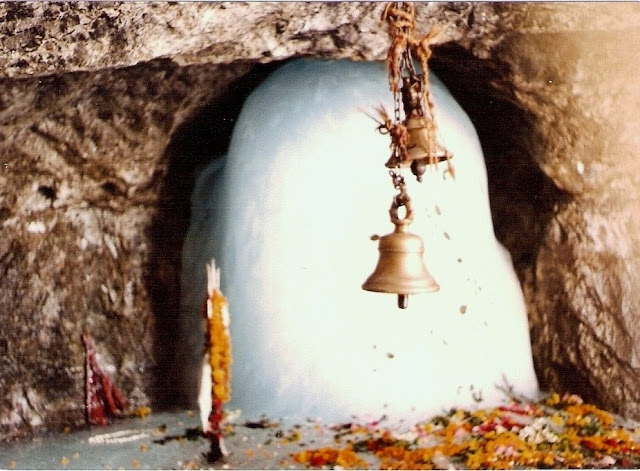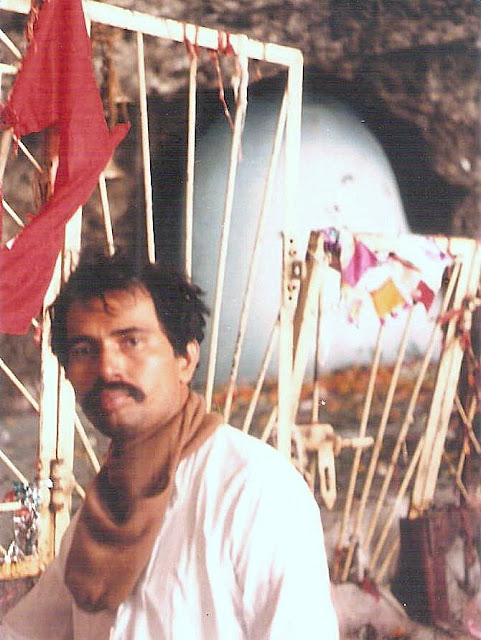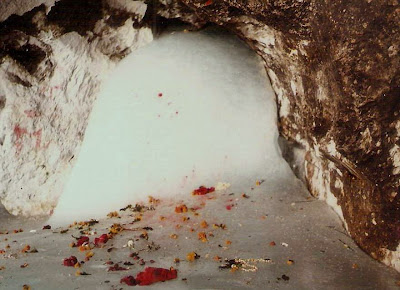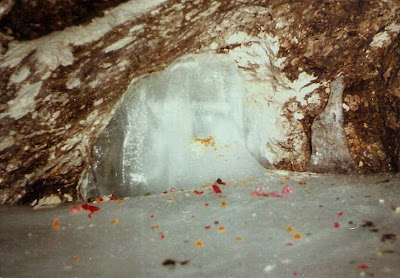My first visit to the Himalaya was by way of a pilgrimage to Amarnath in July 1984. A revisit to Amarnath in July 1987 enforced my belief that Amarnath pilgrimage was more of a faith and will power than a trek with full protective gears. Otherwise, how could one explain pilgrims clad in cotton linens with no proper protective gears for arduous trek could successfully complete the pilgrimage in hostile weather conditions without any trace of tiredness. And then there were some handicapped pilgrims who also successfully completed the pilgrimage to holy cave. These pilgrims were inspiration for our group of seven persons (four of which were with me in our pilgrimage to Amarnath in July 1984) to successfully complete the trek-cum-pilgrimage to Amarnath in July 1987 notwithstanding the worst snow condition in the month of July over a decade.
Padmakar Kale, my office colleague and the leader of our group, who had also taken us to Amarnath in 1984 was aiming his Amarnath hat-trick. As was followed in our previous visit to Amarnath, we planned our itinerary in such a way that we would be reaching the Amarnath Cave on Guru Purnima Day, the full moon day of the Hindu month Ashada when the ice lingam in the holy cave of Amarnath was expected to be the largest and the pilgrim traffic was expected to be less. Those days, the peak pilgrimage season for Amarnath used to be around full moon day of the Hindu month Shravan which mostly falls in August after which the route used to be closed. We also decided to undertake pilgrimage to Vaishno Devi shrine to get her blessing for our Amarnath trek. In a way, it was also an exercise to get attuned to a more difficult trek ahead. The pre-pitched tents at Chandanwadi, Sheshnag and Panchtarani were booked with one of the agencies (I think the name of the agency was Khalsa) based in Pahalgam through letters and a part of money was remitted through Money Order.

Apple eating session in Holiday Home at Jammu.
Laced with my newly acquired Pentax K-1000 SLR camera, on July 2nd, we boarded the early morning Jammu Tawi Superfast Express at Mumbai Central which reached the hot and humid Jammu Tawi around noon the next day. After freshening and resting at a holiday home which was booked by one of our group members, we took an evening bus to Katra. The 50-km bus journey on a narrow road with potholes in many places looked somewhat risky. At some places, the road was so narrow that it was barely sufficient to bus to pass through. After dumping our haversacks in one of the dharamshalas at Katra and finishing our dinner, we started our walk to Vaishnodevi around 10.00 in the night and reached the shrine around 4.00 in the morning on a well-lit path. In less than an hour, we finished our darshan and walked back to Katra at around 8.30 a.m. We were back to our holiday home in Jammu by noon.
Next day, we took an early morning bus to Srinagar. The 300 kms road journey to Srinagar was smooth and took about 11 hours. After staying overnight in Srinagar, next morning, we took a taxi to Pahagam and reconfirmed with the tent agency our tent arrangements. We also arranged one porter to carry some of our luggage. Rest of the day was spent in strolling around the Lidder river.
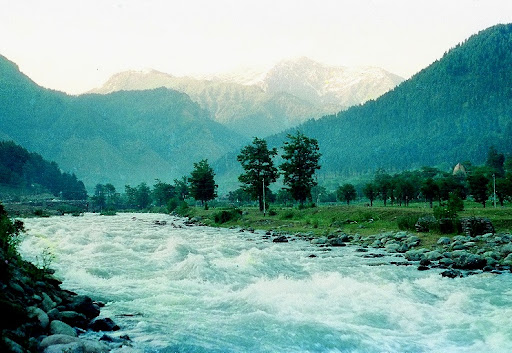
On the mud road to Chandanwari.
Betaab Valley in the background.
Chandanwari campsite across Lidder River.
Day-1 : Pahalgam-Chandanwari (2920m): 16 kms trek
Though there were a couple of share jeeps operating between Pahalgam and Chandanwari, we decided to walk down the distance to get ourselves in good physical conditions as a steep climb of Pisu Top awaited us the next day. After readjusting our luggage between us and the porter, we left our Pahalgam hotel around 8.00 a.m. Initially, we walked on the road for 2-3 kms but seeing the opportunity to cut short the road distance, we used short-cuts through forest path which were not very steep, occasionally joining the road again. On the way, we saw a beautiful valley with a small lake which, according to our porte,r was used for shooting Betaab, a Hindi movie. After crossing a make-shift wooden bridge over Lidder river, we reached our campsite at Chandanwari around 1.00 p.m.
After taking some rest in our allotted two tents, we walked towards the famous snow bridge over Sheshnag stream. There was not much pilgrim crowd as the peak pilgrimage season was yet to start. The snow bridge appeared much wider and longer than the one we had seen in July 1984. Towards evening, some more pilgrims reached the campsite as was evident from the activities outside many tents. The night was very cold and one woollen blanket with rajai provided to each one of us was not sufficient to ward off the cold.
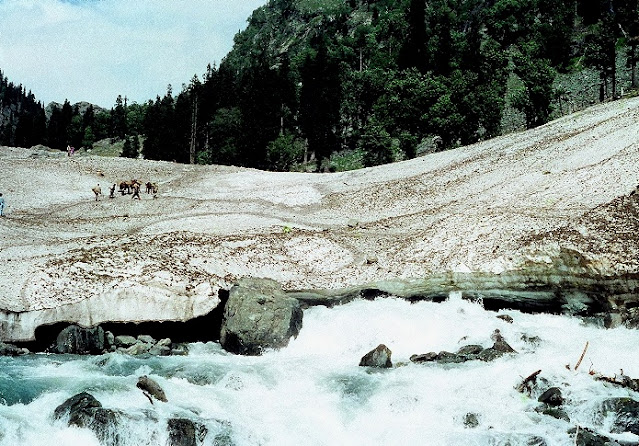
Snow bridge over Sheshnag stream at Chandanwari.
Day-2 : Chandanwari-Sheshnag (3550m) : 12 kms trek
It was the challenging day to start the trek in a real sense as after about one km of walk along the Sheshnag stream, we were to climb to the Pisu Top which was a zigzag steep climb. To avoid the strong sun while climbing Pisu Top, we left Chandanwari at 5.00 a.m. with an intention to reach the Pisu Top before sunrise. This time, none of us faced much difficulty in climbing Pisu Top as the previous experience on this route had thought us that a slow and steady walk with short rest in-between was the best way to tackle the steep climb. As planned, we reached Pisu Top before sunrise. Knowing that pilgrims would take a longer rest on Pisu Top, there were a few dabhas here to cater to the need of pilgrims. We took a break here to complete our breakfast.
From Pisu Top, it was, more or less, a level walk until we encountered our first snow on the path. At first, it looked risky to walk on a snow slope ending towards the Sheshnag stream flowing at the base. But the steps cut on the snow made the walk a bit easy. As we crossed the snow patch, we realised that at mid-point, the lower portion of the snow base had melted making its appearance like a snow cave. There were another two snow patches to be crossed before we reach the base of the second steep climb before Sheshnag campsite. The climb was steep but it was, more or less, straight path making it less strenuous than the Pisu Top climb. After the end of the climb, we saw the first glimpses of Trinity peaks towering over Sheshnag lake. After a level walk of about one km, we reached Sheshnag campsite (the place locally known as Wavazan).
After crossing snow bridge, on way to foot of Pisu Top.
Sadhus smoking chillum before the Pisu Top climb.
Dabhas on Pisu Top.
Pilgrims returning from Amarnath met us on Pisu Top.

After Pisu Top, walk towards Sheshnag.
With two steep climbs, we were really tired when we reached Sheshnag. Instead of getting in to tents, all of us took rest on first meadow overlooking the Sheshnag lake. The location of Sheshnag campsite was very scenic with the constant view of blue water Sheshnag lake and the snow clad Trinity peaks. There were a few dabhas around the campsite. Sheshnag was a very windy place particularly in the afternoon and known for weather turning bad all of a sudden with thunderstorms. Hence, a couple of storm shelters have been constructed by the Government.
When we finally made it to our tents, we were surprised to see a thin layer of fresh snow accumulated around the tents. During day time, the strong sun camouflaged the real intensity of cold as we realised that resting inside the tents was not a good idea. We felt better to spend the time by sitting over a high place overlooking Sheshnag lake. We could see some floating ice slabs in the lake even in the month of July which is the peak summer time. The sky was clear almost the entire day except for a short period when some rain bearing cloud gathered towards evening. However, except for some drizzle, the weather soon cleared making it possible to get a grand view the Trinity peaks and Sheshnag lake in full moon light.
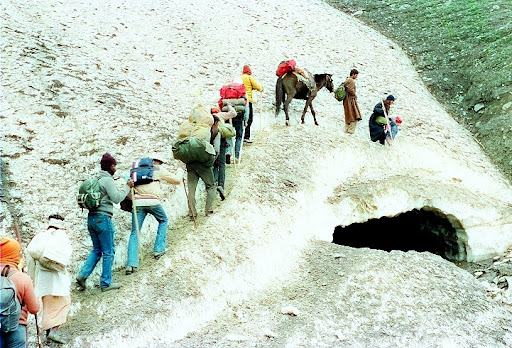
First encounter with snow on way to Sheshnag.
First sighting of wildflower on way to Sheshnag.
Line of pilgrims on mules crossing a small glacier on way to Sheshnag.
A waterfall on way to Sheshnag.
Second climb on way to Sheshnag.
First glimpses of the mouth of Sheshnag Lake with Trinity peaks in the background.
Reflections of glaciers from Trinity peaks on Sheshnag Lake.
Close-up of Sheshnag Lake with floating ice
.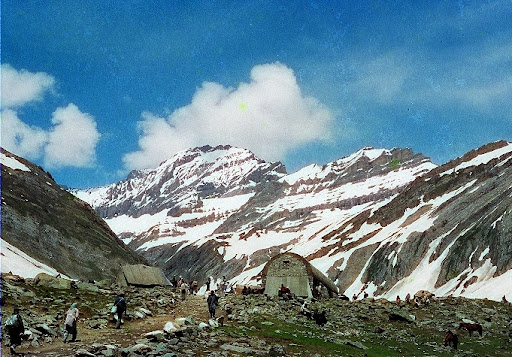
Sheshnag Campsite. On the right is a storm shelter.
Pilgrims arriving at Sheshnag campsite.
Kale and Desai doing savasana on Sheshnag meadow.
Some pilgrims are out strolling in a sunny afternoon at Sheshnag.

A cute girl holding wildflowers with Trinity peaks in the background.
Day-3:Sheshnag-Panchtarani(3660m)-Amarnath(3950m)-Panchtarani:13+6+6 kms trek.
Keeping in view the need to cross the Mahagunas Pass well before noon, we started from Sheshnag at 6.00 a.m. After walking about 200m just before a gradual descent to the trekking path to Mahagunus Pass, we were shocked to see the vast expanse of a thick carpet of snow as far as our eyes could see. It was very unusual to see the snow in the peak summer time. In fact, we had never heard of snow on the route to Amarnath except at places near to Amarnath cave that too in patches. “We are not moving further. Let us return to Pahalgam” was the immediate reaction of Padmakar Kale, our leader. He said that he had never seen so much snow on this route on his previous two visits to Amarnath. In a way, his reaction was understandable as we had not prepared for trekking in the snow conditions. Our hunter shoes were not suitable for snow trek. We were also not having snow axe to make path in case the path became slippery. But at the same time, majority of us were not prepared to abort the trek without giving it a try as far as possible. But our leader was adamant on aborting the trek. After some discussion, we persuaded him to give a try pointing out at some pilgrims, mostly sadhus, who were already on the snow path with bare minimum protections. We all decided that if any one of us found physical discomfort in walking on the snow path, we would all return to Sheshnag.
After covering our socks with plastic sheets to prevent snow and water seeping through the shoes and descending about 200m, we were on the beginning of our snow trail. Initially, the thin snow cover did not pose any problem for us to walk. As we proceeded, the thickness of snow on the trail started increasing. Due to softness of the snow, our feet were going ankle deep in the snow, the deepness increased as we walked further. We then decided to walk in a line holding each other’s hands. Fortunately, footprints of pilgrims on the snow who had gone ahead of us, made our life a bit easier. After about one km of walk, we realised that actually, we were walking on the thick snow slabs of 5-6 feet height as we could gauge the height of the snow slab from the base of a flowing stream beneath the glacier snout. On this patch of snow walk, we encountered a couple of crevasses, but these did not materially obstruct our trail. With this kind of walking on the snow, even our plastic covered socks failed to prevent water seepage from the shoes which made our feet almost numb. Now, we were really looking for some dry patch of land to sit down to remove our shoes and rub the feet to get some sensations back. But we could not see such a place as far as our eyes could see.

Start of the snow line just after one km from Sheshnag.
Walk in line on the snow trail was our motto.
As we proceeded, thin snow cover became thick snow slabs.
Walking by the side of a crevasse.
On way to Mahagunas Pass.
Surprisingly, none of us ever thought of returning to Sheshnag despite the difficult trekking conditions as we were really enjoying our tryst with snow. We were also fortunate to have a clear sky with strong sun. But the near numbness of our feet was causing some anxiety as this could be a precursor to a frost bite. The snow walk continued without any respite and with our restricted pace, we reached Mahagunas Pass around 10.00.a.m. We were assuming that once we crossed the Mahagunas Pass, we were out of the snow line and we could take really a big break to remove our shoes for drying and massage our feet to bring back some sensations. But it was not to be as even after crossing the pass, we were still on the snow carpet. The descent from the pass on the snow made our walk very difficult with all of us sometime or the other slipping over the snow. It was at this time, I recalled my descent from Chandrakani Pass (in Kullu-Manali region) on the snow in June 1986 where we were instructed by the camp leader to use a plastic sheet around our hips, sit down on the ridge holding stick by both hands above our heads and slide down all the way to base of the snowy slope where one more person would hold the slider by hand to prevent him from moving further in an uncharted area. Our porter, who was already ahead of us, was asked to stand at the base of the slope and we, turn by turn, slid the slope and stopped by our porter at the base. Even in times of difficulties, it was sort of entertainments for us to watch our group sliding on the snow slope and in the process getting into bizarre situations. Some of the pilgrims observing our slides also decided to plunge in to this game and were happy to experience the snow slides.
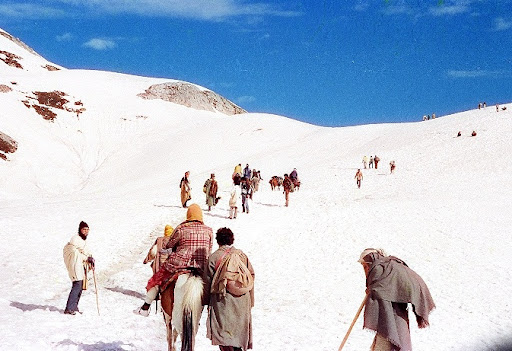
On way to Mahagunus Pass.
Mahagunus Pass.
After the pass, it is downhill all the way.
Way towards Panchtarini. On the left are storm shelters.
The decent on snow trials was a difficult proposition so......
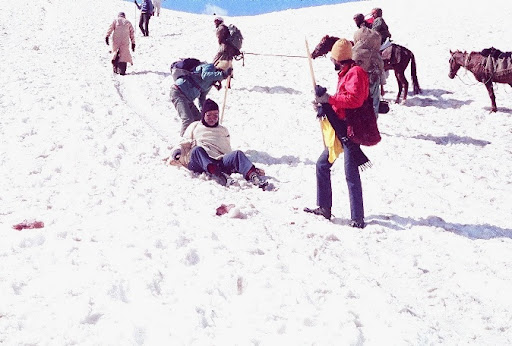
......sliding on the soft snow was faster and safer than walking.
Our descent on snow trail continued albeit with lesser snow accumulation until about one km before Panchtarini campsite. By then, we had already walked about 12 kms continuously on the snow trail. At last, we reached a small meadow on the way to Panchtarini where we decided to take a break to dry our shoes and change the socks. Having completed the snow trail, now most of us were worried as we were set to do the return trek on the same snow trail the next day. At the same breath, we were also admiring the will power of some pilgrims and sadhus who despite having bare minimum protection from cold and snow were a determined lot to reach the holy cave. Certainly, these pilgrims gave us inspiration to move forward to reach our destination. We reached Panchtarini at 1.00 p.m. and after dumping our haversacks and taking bare minimum personal effect, we marched towards the holy cave.
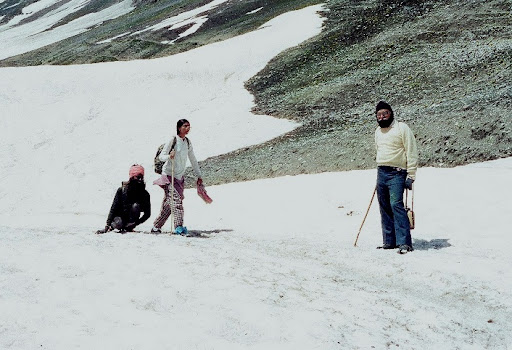
This handicapped pilgrim (left) 'walked' all the way this way - a pilgrimage of faith and will power.
At last pilgrims on a snow-less track to Panchatarini.
Wild flowers on way to Panchtarini.
Wild flowers on way to Panchtarini.
I
Panchtarini meadow.
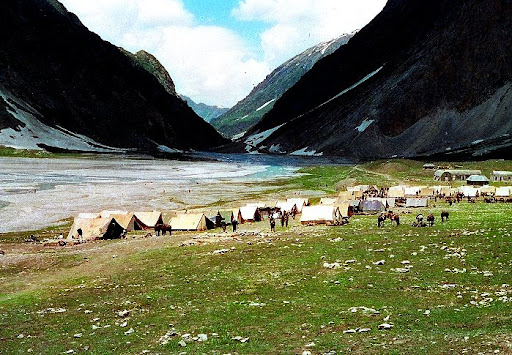
Panchtarini campsite with storm shelters on the right.
I found Panchtarini the most serene place in Amarnath pilgrimage route with five streams flowing through a vast flat meadow skirted by high mountains. After about one km of walk over the Panchtarini meadow, there was a gradual climb by the side of Amarganga stream for the next 2 kms or so. Though the path was free from snow, the there were large snow slabs probably from the winter accumulated snow, on both sides of the stream. The trail veered in to a narrow boat shape valley covered with a thin layer of snow. Even in this inhospitable region, there was a langar in operation where all pilgrims were offered free food and hot beverages. By this time, we were all feeling nauseating and were not in a position to eat anything. As we were within one km from the destination, holy cave was now visible. We reached at around 3.30 p.m. at the base of the holy cave where a few dabhas in tents were set up.
After taking a bath in the ice cold water of Amarganga, we climbed 100 odd stairs to reach the entrance of the holy cave. There was hardly any crowd, and we had an easy darshan of the ice Shivling representing Lord Shiva. The snow-white ice lingam was so huge that it was almost touching the cave roof from where water was regularly dripping on the ice lingam. The entire floor of the holy cave was covered with thick ice making it most uncomfortable to stand barefoot and pray. Somehow, we managed to stand for less than a minute to pray and take blessing from the priest. Next to the left of main ice lingam was two smaller crystal type ice lingam representing Parvati and Ganesh as told to us by the priest. With a good darshan of ice lingam in holy cave, our sense of fulfillment sent the hardship of snow trail into oblivion.

A gentle climb towards holy cave with Panchtarini campsite in the background.
Amarganga stream by the side of trekking path to holy cave.
Amarganga stream emerging from the snout of glacier. It is me on the right.
On the way to holy cave. The steep slope ensured that all snows will accumulate at the base.
Walking through snow covered narrow valley. Amarnath cave is visible at the far-end.
The holy cave in Amarnath.
It was a rare occasion to see the Ice Lingam to its full height as it touched the cave roof.
Me with Ice Lingam in the background.
Ice Lingam representing Parvati.
Ice Lingam representing Lord Ganesh.
By the time, we return to the base of the Amarnath cave, it was nearing 5.00 p.m. and it was getting dark. Some of our members were not keen to walk back 6 kms to Panchtarini due to exhaustion. Although Amarnath cave did not have a formal tent colony for overnight stay and all pilgrims try to return to Panchtarini after completion of darshan at the holy cave, we decided to stay back in Amarnath in one of the dabhas set up under a cave shelter. As the dusk set in, it became unbearable to face cold wind as the dabha did not have enough space to sleep nor had woollen blankets for all of us. Furthermore, water was dripping from the top of the cave probably due to melting of the snow accumulated over the cave. After about 2 hours of stay in the dabha, most of us felt that it would be better to spend night at Panchtarini as originally planned though we may have to do night trekking. Fortunately, being full moon night with clear sky, the trek path was adequately lit. Nonetheless, we all walked in a single line with persons from front and back holding the torches. It took us 2 hours of non-stop walking to reach Panchtarini by 9.00 p.m. The nauseating feeling had withered away as we reached Panchtarini and we were hungry to eat whatever available in dabhas. At the end of this crazy day, we had trekked 25 kms from 6.00 a.m. to 9.00 p.m.
In retrospect, it would have been better if we had proceeded to Amarnath cave the next day early morning instead of proceeding on the same day after reaching Panchtarini. In this way, we would have avoided our foolish decision to do the night trek from Amarnath cave to Panchatarini without affecting our schedule. I shudder to think what would have happened if the weather turned cloudy on the way and our torches’ batteries had exhausted. There were no shelters of any kind from the langer located 1 km before the holy cave till Panchtarini. But once successful, conjectures have no place for discussion.
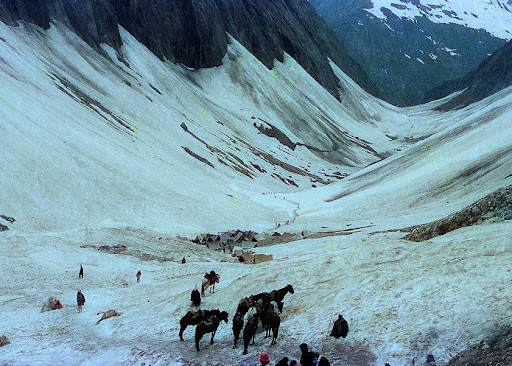 |
| Langar tents in the middle where we were offered chole-bathura and tea. |
Day-4 : Panchtarani-Sheshnag : 13 kms trek.
We commenced our return journey at 6.00 a.m. with the intention of crossing the Mahagunas Pass well before noon. After about one km of walk thorugh meadow, we were again faced with next 12 kms of snow trail. Fortunately, a good weather condition supported us in our endeavour to cross the pass well before noon. However, when we were just one km short of Sheshnag campsite, weather turned bad and we faced hail storm which lasted for about half-an-hour. Some hails were almost of the size of table tennis ball. Since there were no shaded places nearby on the trail, we had to walk amidst hail. We reached Sheshnag campsite around 1.00 p.m. Mehta (60+ age), one of our members collapsed on the iron cot as he reached his tent. Despite shaking him, he was not responding. We got really scared as some started rubbing his palms and feet but still there was no response except some little movement. It was at that point that I offered him a hot cup of tea knowing very well that he was very fond of tea. He responded by waving of his head and took tea in a cup saucer. As soon as he finished his tea, he sat up and started talking in a low voice. It transpired that during hailstorm, he walked briskly to reach the campsite as early as possible as his was not carrying his umbrella (which was with the porter) and in doing so, he developed breathlessness. It was only after gaining normal breathing in the tent that he could drink tea and thereafter he was completely alright with his usual self. We would have proceeded to Chandanwari but for this incidence, we decided to stay overnight in Sheshnag.
Day-5: Sheshnag-Chandanwari-Pahalgam : 12+16=28 kms trek.
We started from Sheshnag at around 6.00 a.m. as we had planned to reach Pahalgam by evening. Since it was mostly descents to Chandanwari and to Pahalgam, we covered a distance of 28 kms in 8 hours. With this, our trek to Amarnath came to an end. After two days each at Pahalgam and Srinagar and one day at Jammu for sight-seeing, we returned to Mumbai by Superfast Express.
All photos by the author.










